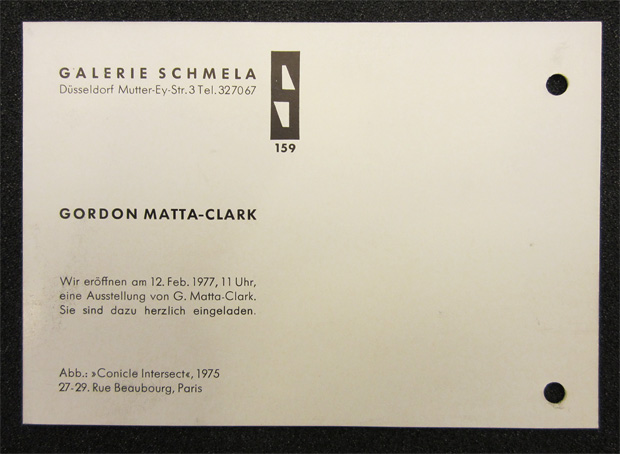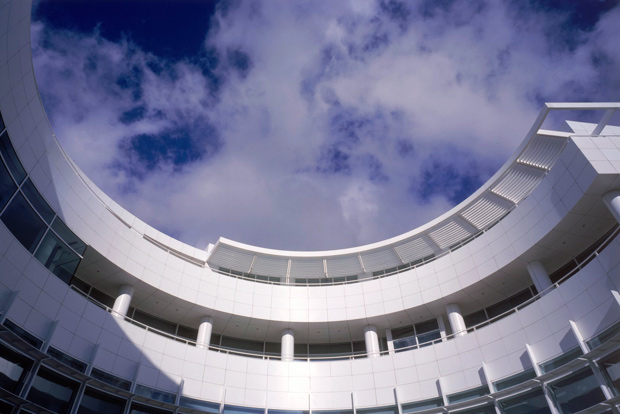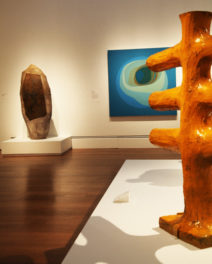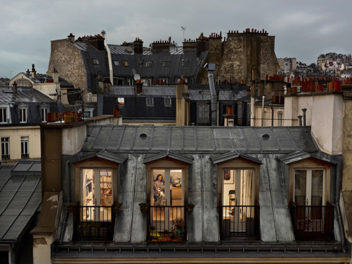
Invitation to the February 12, 1977, gallery opening of Gordon Matta-Clark’s exhibition at Galerie Schmela, Düsseldorf. Galerie Schmela records. The Getty Research Institute, 2007.M.17
A new display case about American artist Gordon Matta-Clark just opened at the Research Library at the Getty Research Institute. I selected the items in the small case—which is just past the reception desk of the Research Institute lobby—from the archive of the German art dealer Alfred Schmela.
On view are the artist’s instructions for the assembly and installation of an Office Baroque cutout object, hand written and illustrated with drawings and a color photograph. They were sent by the artist to Alfred Schmela in planning for Matta-Clark’s first exhibition in Germany, which was his first in Europe as well.
Also on display are the Schmela Gallery invitation for the exhibition opening and its first press review. I’ve also included a February 1978 letter from Matta-Clark to Alfred Schmela, in which he describes a building-cut project he was intending to show at Schmela’s outdoor exhibition space in Düsseldorf, Lantz’sche Park. The plan was to cut out sections of an abandoned factory roof and transport them on several flatbed trucks as “an architectural parade through Düsseldorf.” This project was not realized, however, due to the artist’s health problems. Matta-Clark died of cancer at age 35 on August 27, 1978.

The exhibition at the Schmela Gallery took place from February 12 to March 17, 1977. On display were color photographs of architectural sites taken before and after they were cut, and three-dimensional objects, including the Office Baroque cutout in the color photograph shown in the display case.
Office Baroque was one of Matta-Clark’s most remarkable projects. In 1977, together with leading Belgian curator Florent Bex, the artist was able to secure an abandoned office building in Antwerp. By cutting out pieces of the walls, ceilings, and roof, Matta-Clark created the impression of a spatial drawing incised into the building. Utilizing all five floors and the roof, he orchestrated a multi-level structure with openings in the shape of circular arcs that modulated the space as the properties and size of rooms changed throughout the building. The result was a series of arabesque slices opening the whole structure to an ever-changing promenade of internal views and unexpected vistas. Matta-Clark documented these spatial relations in photographs. Some of the cut-out objects became sculptures in their own right.
The art critic Helga Meister wrote about the exhibition in the German newspaper Westdeutsche Zeitung. Her review, shown in the display case, begins with words “Der Himmel bekommt eine Chance,” which means “The sky gets a chance.” Meister concludes passionately (translation is my own):
…by applying brute force as if using only paper scissors, Matta-Clark destructs more than what is rooted in history! By taking out exterior walls he directly opposes the century-long tradition to build with obstructing the view…this skill seems forgotten in our homes. Ceilings create darkness. We don’t give the sky a chance. To point this out is a great achievement, and if a pneumatic hammer is needed to raise our awareness so it is not a joke or a gag, but a serious accusation!
The central interior space of the Getty Research Institute building is brightly lit and wide open to the sky, and in that respect it is the perfect place to show ideas of an artist who wanted to “give the sky a chance”: Gordon Matta-Clark.


See all posts in this series »




Comments on this post are now closed.